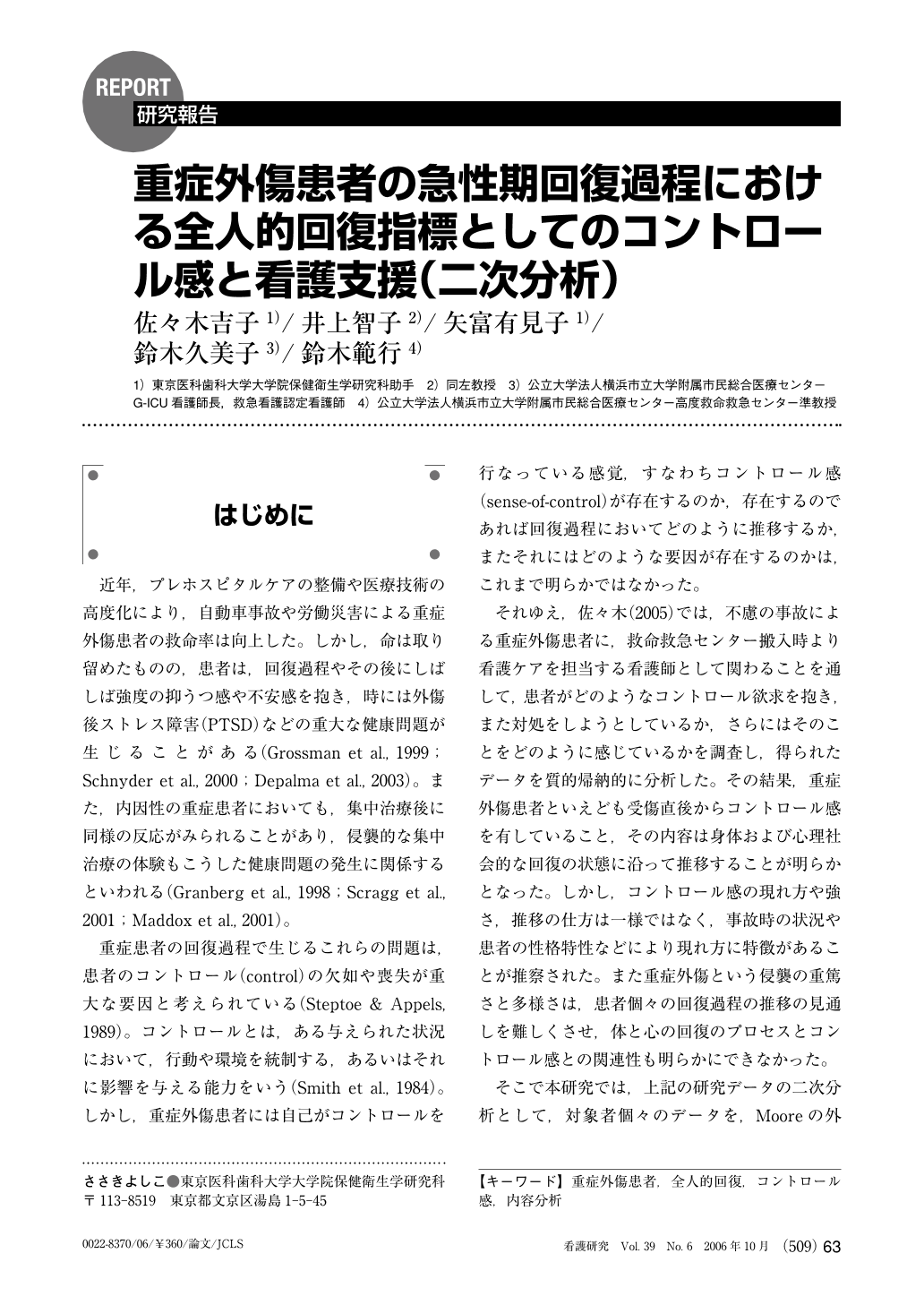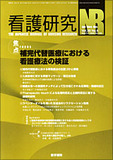Japanese
English
- 有料閲覧
- Abstract 文献概要
- 1ページ目 Look Inside
- 参考文献 Reference
はじめに
近年,プレホスピタルケアの整備や医療技術の高度化により,自動車事故や労働災害による重症外傷患者の救命率は向上した。しかし,命は取り留めたものの,患者は,回復過程やその後にしばしば強度の抑うつ感や不安感を抱き,時には外傷後ストレス障害(PTSD)などの重大な健康問題が生じることがある(Grossman et al., 1999; Schnyder et al., 2000;Depalma et al., 2003)。また,内因性の重症患者においても,集中治療後に同様の反応がみられることがあり,侵襲的な集中治療の体験もこうした健康問題の発生に関係するといわれる(Granberg et al., 1998;Scragg et al., 2001;Maddox et al., 2001)。
重症患者の回復過程で生じるこれらの問題は,患者のコントロール(control)の欠如や喪失が重大な要因と考えられている(Steptoe & Appels, 1989)。コントロールとは,ある与えられた状況において,行動や環境を統制する,あるいはそれに影響を与える能力をいう(Smith et al., 1984)。しかし,重症外傷患者には自己がコントロールを行なっている感覚,すなわちコントロール感(sense-of-control)が存在するのか,存在するのであれば回復過程においてどのように推移するか,またそれにはどのような要因が存在するのかは,これまで明らかではなかった。
それゆえ,佐々木(2005)では,不慮の事故による重症外傷患者に,救命救急センター搬入時より看護ケアを担当する看護師として関わることを通して,患者がどのようなコントロール欲求を抱き,また対処をしようとしているか,さらにはそのことをどのように感じているかを調査し,得られたデータを質的帰納的に分析した。その結果,重症外傷患者といえども受傷直後からコントロール感を有していること,その内容は身体および心理社会的な回復の状態に沿って推移することが明らかとなった。しかし,コントロール感の現れ方や強さ,推移の仕方は一様ではなく,事故時の状況や患者の性格特性などにより現れ方に特徴があることが推察された。また重症外傷という侵襲の重篤さと多様さは,患者個々の回復過程の推移の見通しを難しくさせ,体と心の回復のプロセスとコントロール感との関連性も明らかにできなかった。
そこで本研究では,上記の研究データの二次分析として,対象者個々のデータを,Mooreの外科的侵襲からの身体的な回復過程のスケール(Moore,1959)に従って回復段階別に区切り,内容分析を行なった。各相において顕著に存在するコントロール感を示し,これらを重症外傷患者の急性期回復過程における,全人的な回復状況を判断するための指標として整理した。さらに,これらに基づいて,重症外傷患者の回復を促進するための有効な看護支援について検討した。
Experiencing a critical injury or an invasive treatment can cause severe depression or strong anxiety and may trigger serious health problems. A lack or loss of self-control is considered a significant factor in the development of such health problems. In our previous study, we investigated sense-of-control in patients who were recovering from critical injuries and demonstrated transition patterns in this ability. However, the patterns of sense-of-control varied among the patients; we suggested that these pattern differences may depend on the circumstances underlying the accidents experienced by the patients or the characteristics of the patients’ personalities. In addition, differences in severity and invasiveness make it difficult to predict an individual patient's recovery from severe injury, and physical and mental recovery processes have not yet been clarified, nor has the relationship between physical and mental factors. In this study, therefore, we performed a content analysis as a secondary analysis of data on the study's subjects; the data was classified according to the scale developed by Moore for the physical process of recovery from invasiveness. Furthermore, we focused on the patients’ sense-of-control at several time points and used this factor as an index of total recovery during the acute recovery phase of critically injured patients. As a result, the relationship between the actual physical recovery and the patients’ sense-of-control as well as differences in the types of sense-of-control were identified and examined.

Copyright © 2006, Igaku-Shoin Ltd. All rights reserved.


